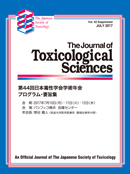The 50th Annual Meeting of the Japanese Society of Toxicology
Displaying 51-100 of 555 articles from this issue
Symposium 9: Cardiovascular adaptive homeostasis and dysregulation: toward drug toxicity assessment
-
Session ID: S9-1
Published: 2023
Released on J-STAGE: March 08, 2024
Download PDF (3019K) -
Session ID: S9-2
Published: 2023
Released on J-STAGE: March 08, 2024
Download PDF (3017K) -
Session ID: S9-3
Published: 2023
Released on J-STAGE: March 08, 2024
Download PDF (3017K) -
Session ID: S9-4
Published: 2023
Released on J-STAGE: March 08, 2024
Download PDF (3019K)
Symposium 10: DX as practiced in the pharmaceutical industry: toxicology research/non-clinical areas
-
Session ID: S10-1
Published: 2023
Released on J-STAGE: March 08, 2024
Download PDF (3015K) -
Session ID: S10-2
Published: 2023
Released on J-STAGE: March 08, 2024
Download PDF (3013K) -
Session ID: S10-3
Published: 2023
Released on J-STAGE: March 08, 2024
Download PDF (3019K) -
Session ID: S10-4
Published: 2023
Released on J-STAGE: March 08, 2024
Download PDF (3010K) -
Session ID: S10-5
Published: 2023
Released on J-STAGE: March 08, 2024
Download PDF (3022K)
Symposium 11: New challenges of developmental neurobehavioral toxicity
-
Session ID: S11-1
Published: 2023
Released on J-STAGE: March 08, 2024
Download PDF (3014K) -
Session ID: S11-2
Published: 2023
Released on J-STAGE: March 08, 2024
Download PDF (3014K) -
Session ID: S11-3
Published: 2023
Released on J-STAGE: March 08, 2024
Download PDF (3016K) -
Session ID: S11-4
Published: 2023
Released on J-STAGE: March 08, 2024
Download PDF (3020K)
Symposium 12: New era of education and research in forensic toxicology
-
Session ID: S12-1
Published: 2023
Released on J-STAGE: March 08, 2024
Download PDF (3019K) -
Session ID: S12-2
Published: 2023
Released on J-STAGE: March 08, 2024
Download PDF (3015K) -
Session ID: S12-3
Published: 2023
Released on J-STAGE: March 08, 2024
Download PDF (3011K) -
Session ID: S12-4
Published: 2023
Released on J-STAGE: March 08, 2024
Download PDF (3014K)
Symposium 13: Concepts of risk for developmental toxicity via male reproduction in pharmaceuticals
-
Session ID: S13-1
Published: 2023
Released on J-STAGE: March 08, 2024
Download PDF (3014K) -
Session ID: S13-2
Published: 2023
Released on J-STAGE: March 08, 2024
Download PDF (3014K) -
Session ID: S13-3
Published: 2023
Released on J-STAGE: March 08, 2024
Download PDF (3019K) -
Session ID: S13-4
Published: 2023
Released on J-STAGE: March 08, 2024
Download PDF (3014K)
Symposium 14: Developments in Research on Carcinogenesis Caused by Disruption of Cell Cycle Regulation
-
Session ID: S14-1
Published: 2023
Released on J-STAGE: March 08, 2024
Download PDF (3014K) -
Session ID: S14-2
Published: 2023
Released on J-STAGE: March 08, 2024
Download PDF (3020K) -
Session ID: S14-3
Published: 2023
Released on J-STAGE: March 08, 2024
Download PDF (3016K) -
Session ID: S14-4
Published: 2023
Released on J-STAGE: March 08, 2024
Download PDF (3014K)
Symposium 15: Current issues of toxicology in CRO industry
-
Session ID: S15-1
Published: 2023
Released on J-STAGE: March 08, 2024
Download PDF (3017K) -
Session ID: S15-2
Published: 2023
Released on J-STAGE: March 08, 2024
Download PDF (3012K)
Symposium 16: SOT Joint Symposium: Approaches for assessment of environmental exposures and immunotoxicity during susceptible life stages
-
Session ID: S16-1
Published: 2023
Released on J-STAGE: March 08, 2024
Download PDF (3021K) -
Session ID: S16-2
Published: 2023
Released on J-STAGE: March 08, 2024
Download PDF (3017K) -
Session ID: S16-3
Published: 2023
Released on J-STAGE: March 08, 2024
Download PDF (3016K) -
Session ID: S16-4
Published: 2023
Released on J-STAGE: March 08, 2024
Download PDF (3016K)
Symposium 17: Current trends and research in genome instability
-
Session ID: S17-1
Published: 2023
Released on J-STAGE: March 08, 2024
Download PDF (3022K) -
Session ID: S17-2
Published: 2023
Released on J-STAGE: March 08, 2024
Download PDF (3020K) -
Session ID: S17-3
Published: 2023
Released on J-STAGE: March 08, 2024
Download PDF (3014K) -
Session ID: S17-4
Published: 2023
Released on J-STAGE: March 08, 2024
Download PDF (3024K) -
Session ID: S17-5
Published: 2023
Released on J-STAGE: March 08, 2024
Download PDF (3019K)
Symposium 18: Current Application and Future Prospects of Data Science in Toxicology / Safety Evaluation
-
Session ID: S18-1
Published: 2023
Released on J-STAGE: March 08, 2024
Download PDF (3017K) -
Session ID: S18-2
Published: 2023
Released on J-STAGE: March 08, 2024
Download PDF (3019K) -
Session ID: S18-3
Published: 2023
Released on J-STAGE: March 08, 2024
Download PDF (3020K) -
Session ID: S18-4
Published: 2023
Released on J-STAGE: March 08, 2024
Download PDF (3015K)
Symposium 19: JCA-JSOT Joint Symposium: Anticancer drug development and toxicology
-
Session ID: S19-1
Published: 2023
Released on J-STAGE: March 08, 2024
Download PDF (3020K) -
Session ID: S19-2
Published: 2023
Released on J-STAGE: March 08, 2024
Download PDF (3016K) -
Session ID: S19-3
Published: 2023
Released on J-STAGE: March 08, 2024
Download PDF (3014K)
Symposium 20: What is Immunotoxicology? -Toxicological Effects on “Immune Cells at Work”, Activation or Suppression-
-
Session ID: S20-1
Published: 2023
Released on J-STAGE: March 08, 2024
Download PDF (3025K) -
Session ID: S20-2
Published: 2023
Released on J-STAGE: March 08, 2024
Download PDF (3014K) -
Session ID: S20-3
Published: 2023
Released on J-STAGE: March 08, 2024
Download PDF (3016K) -
Session ID: S20-4
Published: 2023
Released on J-STAGE: March 08, 2024
Download PDF (3019K) -
Session ID: S20-5
Published: 2023
Released on J-STAGE: March 08, 2024
Download PDF (3015K)
Symposium 21: Gender differences in adverse drug reactions
-
Session ID: S21-1
Published: 2023
Released on J-STAGE: March 08, 2024
Download PDF (3019K) -
Session ID: S21-2
Published: 2023
Released on J-STAGE: March 08, 2024
Download PDF (3017K)
